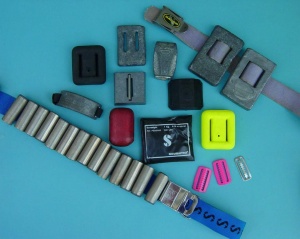Weight system
A weight system in diving is needed to compensate for positive buoyancy of the diving suit and other equipment. It is needed to achieve neutral buoyancy to be able to hover in mid water at every depth. Due to its high density the preferred material for weights in diving is lead.
Contents
Basic knowledge for Open Water Diver* (OWD*)
Since your diving equipment over all is usually positive buoyant, you have to add some additional weight to be able to descend and achieve neutral buoyancy. Lead is the ideal material because of its high density of 11.34 kg/dm3. This means that the same volume of lead is 11.34 times heavier than water.
Lead weights for diving are available in various variations with typical weights of 0.5 kg, 1 kg, 2 kg, 2.5 kg and 5 kg.
Amount of weight
The correct amount of weight can only be determined in a check dive, since it depends on many factors. At the beginning of the dive, you should float at eye level with an empty BCD, a full diving cylinder while holding a normal breath of air. As you exhale, you should start to sink (also refer to section Amount of lead weights in article Buoancy control).
Because of its higher density, you need more weight in salt water than in fresh water. A thicker wetsuit also requires a larger amount of weight.
You should not take too much or too little weight. If you use too much weight, you have to compensate for too much downward force with additional air in your BCD. The air changes its volume with every change in depth. As more air you need in your BCD as more you need to compensate for pressure changes. In addition, moving through the water needs more effort due to a bigger volume of your BCD. Both significantly increase your air consumption. Furthermore, the BCD may not have enough buoyancy volume to compensate for the additional downward force caused by unnecessary weight, especially at greater depths. On the other hand, if you use too little weight, at the end of the dive you will have severe problems achieving neutral buoyancy in shallow water during the deco or safety stop.
Weight belt & weight pockets
The weights are either threaded on a weight belt or stowed in the weight pockets of the BCD. The weights should be on the side of the body, evenly distributed, not able to slip on the weight belt and placed in the BCD's weight pockets so that they cannot be accidentally lost.
Weight release
In both systems, it must be possible to be able to release the weight quickly and safely even with thick gloves in an emergency. Therefore, the weight belt should be a little longer and the end should stick out from the body. In an emergency, you can pull at the end so that the quick release buckle opens by itself.
By dropping the weight, you lose the ability to ascend in a controlled manner and perform a mandatory deco stop or a safety stop. However, in a real emergency, you should better risk decompression sickness than drowning deep down. Most of the fatal diving accidents could have been avoided if the diver had dropped the weights.
- Warning
As long as you are wearing your weight system, you have to wear also your scuba gear. If you slip and fall into the water especially if you dive from a boat or on deep water entries you mandatory need your BCD to compensate for the heavy weights. Therefore put on your weight belt last and remove it as first item of your equipment.
